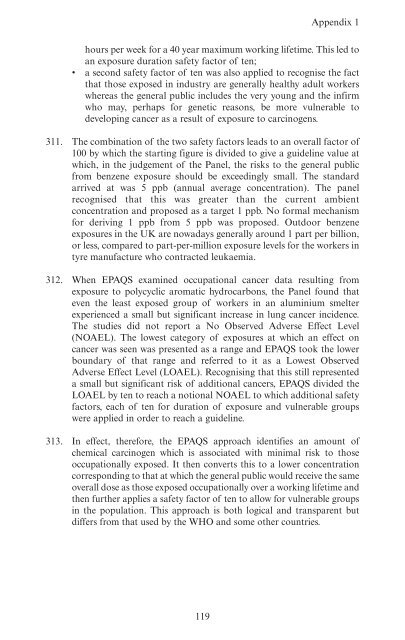Guidelines for Metals and Metalloids in Ambient ... - ARCHIVE: Defra
Guidelines for Metals and Metalloids in Ambient ... - ARCHIVE: Defra
Guidelines for Metals and Metalloids in Ambient ... - ARCHIVE: Defra
You also want an ePaper? Increase the reach of your titles
YUMPU automatically turns print PDFs into web optimized ePapers that Google loves.
Appendix 1<br />
hours per week <strong>for</strong> a 40 year maximum work<strong>in</strong>g lifetime. This led to<br />
an exposure duration safety factor of ten;<br />
• a second safety factor of ten was also applied to recognise the fact<br />
that those exposed <strong>in</strong> <strong>in</strong>dustry are generally healthy adult workers<br />
whereas the general public <strong>in</strong>cludes the very young <strong>and</strong> the <strong>in</strong>firm<br />
who may, perhaps <strong>for</strong> genetic reasons, be more vulnerable to<br />
develop<strong>in</strong>g cancer as a result of exposure to carc<strong>in</strong>ogens.<br />
311. The comb<strong>in</strong>ation of the two safety factors leads to an overall factor of<br />
100 by which the start<strong>in</strong>g figure is divided to give a guidel<strong>in</strong>e value at<br />
which, <strong>in</strong> the judgement of the Panel, the risks to the general public<br />
from benzene exposure should be exceed<strong>in</strong>gly small. The st<strong>and</strong>ard<br />
arrived at was 5 ppb (annual average concentration). The panel<br />
recognised that this was greater than the current ambient<br />
concentration <strong>and</strong> proposed as a target 1 ppb. No <strong>for</strong>mal mechanism<br />
<strong>for</strong> deriv<strong>in</strong>g 1 ppb from 5 ppb was proposed. Outdoor benzene<br />
exposures <strong>in</strong> the UK are nowadays generally around 1 part per billion,<br />
or less, compared to part-per-million exposure levels <strong>for</strong> the workers <strong>in</strong><br />
tyre manufacture who contracted leukaemia.<br />
312. When EPAQS exam<strong>in</strong>ed occupational cancer data result<strong>in</strong>g from<br />
exposure to polycyclic aromatic hydrocarbons, the Panel found that<br />
even the least exposed group of workers <strong>in</strong> an alum<strong>in</strong>ium smelter<br />
experienced a small but significant <strong>in</strong>crease <strong>in</strong> lung cancer <strong>in</strong>cidence.<br />
The studies did not report a No Observed Adverse Effect Level<br />
(NOAEL). The lowest category of exposures at which an effect on<br />
cancer was seen was presented as a range <strong>and</strong> EPAQS took the lower<br />
boundary of that range <strong>and</strong> referred to it as a Lowest Observed<br />
Adverse Effect Level (LOAEL). Recognis<strong>in</strong>g that this still represented<br />
a small but significant risk of additional cancers, EPAQS divided the<br />
LOAEL by ten to reach a notional NOAEL to which additional safety<br />
factors, each of ten <strong>for</strong> duration of exposure <strong>and</strong> vulnerable groups<br />
were applied <strong>in</strong> order to reach a guidel<strong>in</strong>e.<br />
313. In effect, there<strong>for</strong>e, the EPAQS approach identifies an amount of<br />
chemical carc<strong>in</strong>ogen which is associated with m<strong>in</strong>imal risk to those<br />
occupationally exposed. It then converts this to a lower concentration<br />
correspond<strong>in</strong>g to that at which the general public would receive the same<br />
overall dose as those exposed occupationally over a work<strong>in</strong>g lifetime <strong>and</strong><br />
then further applies a safety factor of ten to allow <strong>for</strong> vulnerable groups<br />
<strong>in</strong> the population. This approach is both logical <strong>and</strong> transparent but<br />
differs from that used by the WHO <strong>and</strong> some other countries.<br />
119
















